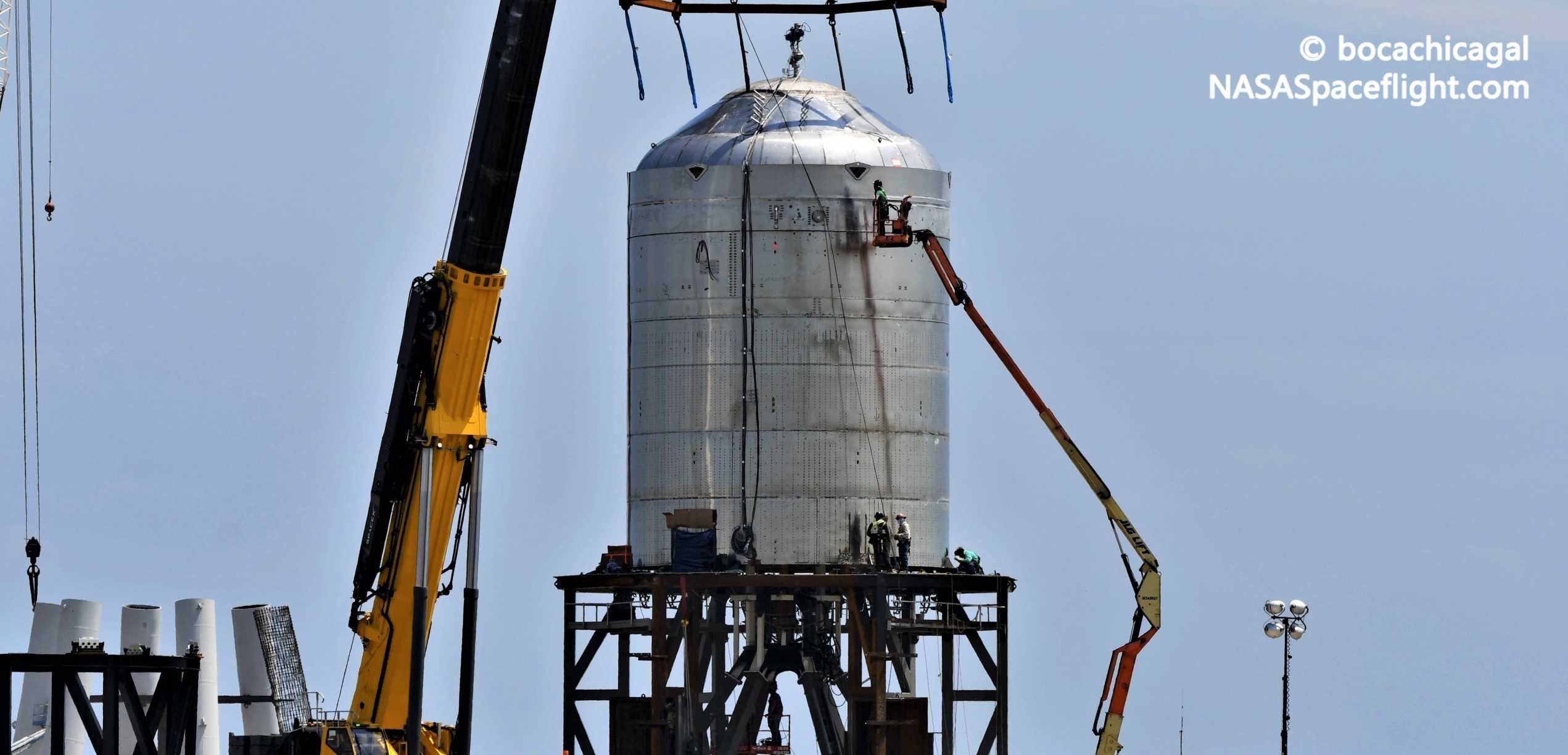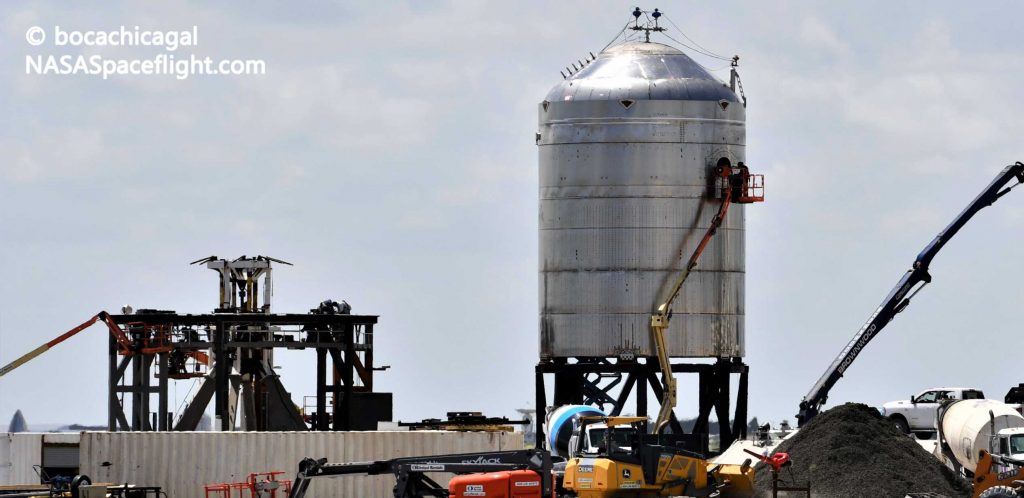

News
SpaceX Starship test tank set for destructive finale after ‘cryo proof’
SpaceX’s fourth Starship test tank is set for a destructive finale after completing a “cryo proof” pressure test on Thursday.
SpaceX’s newest Starship test tank – SN7.1 – is the second in a series of two planned prototypes, both designed to test the viability of using a new steel alloy to build future Starships and Super Heavy boosters. CEO Elon Musk says that SpaceX is technically customizing its own steel alloy for Starship production but Musk’s comments and the results from SN7 testing in June 2020 point towards an offshoot of 304L with minor metallurgical tweaks.
Prior to SN7’s test campaign, Musk revealed that the main goal of the new alloy was to reduce the brittleness of Starship tanks and any adjacent steel components under cryogenic conditions (i.e. extreme cold). Ultimately, SN7 appeared to confirm that the new alloy’s behavior was far more forgiving under cryogenic loads, reaching what were believed to be record pressures before the tank finally burst on June 24th.
Following in SN7’s footsteps, SN7.1 is much closer to an actual Starship prototype.
“SN7.1 is significantly more complex than its sibling and will test a ~304L Raptor mount (thrust puck) and skirt section. The forces and general conditions those new parts will be subjected to are substantially different than most of what SN7 was subjected to, meaning that there is a chance that 304L steel is actually worse in some scenarios.
With any luck, though, SN7.1’s test campaign – scheduled to begin as early as 9pm CDT (UTC-5), September 10th – will be a flawless success, proving that SpaceX’s new steel alloy is superior to 301 for all Starship-related applications. If that’s the case, Starship SN8 – the first full new-alloy prototype – will likely be fully outfitted with a nosecone and header tanks before beginning acceptance testing later this month.”
Teslarati.com — September 10th, 2020
For SN7.1, increased ductility could theoretically be a mixed bag. Assuming SpaceX has also built the thrust puck out of 304L-adjacent steel, it may end up being too squishy under the extreme forces it will be subjected to. At full throttle, the thrust of three Raptor engines will compress the thrust puck – a cone with dimensions roughly the same as a large circular table – with the equivalent force of a ~600 metric ton (1.3 million lb) weight.

On September 10th, SpaceX put SN7.1 through its paces, performing a cryogenic proof test with liquid nitrogen (LN2) while the tank was still installed on the simple steel frame used to support it during production and transport. That simple decision offers a brief glimpse at the extensive planning that allows SpaceX to optimize for speed and efficiency while still conducting successful tests. While SpaceX could have technically installed SN7.1 directly onto a brand new launch mount custom-built for the exact kind of testing expected, the company instead left the tank on its build stand – much cheaper and far easier to replace than the former.
Technically, moving directly to the launch mount would have slightly simplified the test process, but a tank rupture during a routine cryogenic proof test could have extensively damaged or destroyed the mount, requiring weeks of work to build a full replacement. After SN7.1 successfully completed a cryogenic pressure test on September 10th, SpaceX simply lifted it off its work stand and installed it on a custom-built launch mount.

As early as 9pm CDT (UTC-5) on September 14th, SpaceX will once again load SN7.1 with liquid nitrogen. This time around, the tank – after reaching flight pressures of 7.5 to 8+ bar (110-120+ psi) – will be subjected to the simulated thrust of three Raptor engines by a series of hydraulic rams. Based on a public schedule of road closures, at least two tests are planned. The first will likely put SN7.1 through a range of Raptor thrust scenarios and profiles under the same tank pressures needed for orbital Starship flights. If that test is successful, SpaceX may move SN7.1 back to its work stand before intentionally pressurizing the tank until it bursts sometime around September 17th.
Check out Teslarati’s Marketplace! We offer Tesla accessories, including for the Tesla Cybertruck and Tesla Model 3.

News
Tesla aims to combat common Full Self-Driving problem with new patent
Tesla writes in the patent that its autonomous and semi-autonomous vehicles are heavily reliant on camera systems to navigate and interact with their environment.

Tesla is aiming to combat a common Full Self-Driving problem with a new patent.
One issue with Tesla’s vision-based approach is that sunlight glare can become a troublesome element of everyday travel. Full Self-Driving is certainly an amazing technology, but there are still things Tesla is aiming to figure out with its development.
Unfortunately, it is extremely difficult to get around this issue, and even humans need ways to combat it when they’re driving, as we commonly use sunglasses or sun visors to give us better visibility.
Cameras obviously do not have these ways to fight sunglare, but a new patent Tesla recently had published aims to fight this through a “glare shield.”
Tesla writes in the patent that its autonomous and semi-autonomous vehicles are heavily reliant on camera systems to navigate and interact with their environment.

The ability to see surroundings is crucial for accurate performance, and glare is one element of interference that has yet to be confronted.
Tesla described the patent, which will utilize “a textured surface composed of an array of micro-cones, or cone-shaped formations, which serve to scatter incident light in various directions, thereby reducing glare and improving camera vision.”

The patent was first spotted by Not a Tesla App.
The design of the micro-cones is the first element of the puzzle to fight the excess glare. The patent says they are “optimized in size, angle, and orientation to minimize Total Hemispherical Reflectance (THR) and reflection penalty, enhancing the camera’s ability to accurately interpret visual data.”
Additionally, there is an electromechanical system for dynamic orientation adjustment, which will allow the micro-cones to move based on the angle of external light sources.
This is not the only thing Tesla is mulling to resolve issues with sunlight glare, as it has also worked on two other ways to combat the problem. One thing the company has discussed is a direct photon count.
CEO Elon Musk said during the Q2 Earnings Call:
“We use an approach which is direct photon count. When you see a processed image, so the image that goes from the sort of photon counter — the silicon photon counter — that then goes through a digital signal processor or image signal processor, that’s normally what happens. And then the image that you see looks all washed out, because if you point the camera at the sun, the post-processing of the photon counting washes things out.”
Future Hardware iterations, like Hardware 5 and Hardware 6, could also integrate better solutions for the sunglare issue, such as neutral density filters or heated lenses, aiming to solve glare more effectively.
Elon Musk
Delaware Supreme Court reinstates Elon Musk’s 2018 Tesla CEO pay package
The unanimous decision criticized the prior total rescission as “improper and inequitable,” arguing that it left Musk uncompensated for six years of transformative leadership at Tesla.

The Delaware Supreme Court has overturned a lower court ruling, reinstating Elon Musk’s 2018 compensation package originally valued at $56 billion but now worth approximately $139 billion due to Tesla’s soaring stock price.
The unanimous decision criticized the prior total rescission as “improper and inequitable,” arguing that it left Musk uncompensated for six years of transformative leadership at Tesla. Musk quickly celebrated the outcome on X, stating that he felt “vindicated.” He also shared his gratitude to TSLA shareholders.
Delaware Supreme Court makes a decision
In a 49-page ruling Friday, the Delaware Supreme Court reversed Chancellor Kathaleen McCormick’s 2024 decision that voided the 2018 package over alleged board conflicts and inadequate shareholder disclosures. The high court acknowledged varying views on liability but agreed rescission was excessive, stating it “leaves Musk uncompensated for his time and efforts over a period of six years.”
The 2018 plan granted Musk options on about 304 million shares upon hitting aggressive milestones, all of which were achieved ahead of time. Shareholders overwhelmingly approved it initially in 2018 and ratified it once again in 2024 after the Delaware lower court struck it down. The case against Musk’s 2018 pay package was filed by plaintiff Richard Tornetta, who held just nine shares when the compensation plan was approved.
A hard-fought victory
As noted in a Reuters report, Tesla’s win avoids a potential $26 billion earnings hit from replacing the award at current prices. Tesla, now Texas-incorporated, had hedged with interim plans, including a November 2025 shareholder-approved package potentially worth $878 billion tied to Robotaxi and Optimus goals and other extremely aggressive operational milestones.
The saga surrounding Elon Musk’s 2018 pay package ultimately damaged Delaware’s corporate appeal, prompting a number of high-profile firms, such as Dropbox, Roblox, Trade Desk, and Coinbase, to follow Tesla’s exodus out of the state. What added more fuel to the issue was the fact that Tornetta’s legal team, following the lower court’s 2024 decision, demanded a fee request of more than $5.1 billion worth of TSLA stock, which was equal to an hourly rate of over $200,000.
Delaware Supreme Court Elon Musk 2018 Pay Package by Simon Alvarez
News
Tesla Cybercab tests are going on overdrive with production-ready units
Tesla is ramping its real-world tests of the Cybercab, with multiple sightings of the vehicle being reported across social media this week.

Tesla is ramping its real-world tests of the Cybercab, with multiple sightings of the autonomous two-seater being reported across social media this week. Based on videos of the vehicle that have been shared online, it appears that Cybercab tests are underway across multiple states.
Recent Cybercab sightings
Reports of Cybercab tests have ramped this week, with a vehicle that looked like a production-ready prototype being spotted at Apple’s Visitor Center in California. The vehicle in this sighting was interesting as it was equipped with a steering wheel. The vehicle also featured some changes to the design of its brake lights.
The Cybercab was also filmed testing at the Fremont factory’s test track, which also seemed to involve a vehicle that looked production-ready. This also seemed to be the case for a Cybercab that was spotted in Austin, Texas, which happened to be undergoing real-world tests. Overall, these sightings suggest that Cybercab testing is fully underway, and the vehicle is really moving towards production.
Production design all but finalized?
Recently, a near-production-ready Cybercab was showcased at Tesla’s Santana Row showroom in San Jose. The vehicle was equipped with frameless windows, dual windshield wipers, powered butterfly door struts, an extended front splitter, an updated lightbar, new wheel covers, and a license plate bracket. Interior updates include redesigned dash/door panels, refined seats with center cupholders, updated carpet, and what appeared to be improved legroom.
There seems to be a pretty good chance that the Cybercab’s design has been all but finalized, at least considering Elon Musk’s comments at the 2025 Annual Shareholder Meeting. During the event, Musk confirmed that the vehicle will enter production around April 2026, and its production targets will be quite ambitious.








